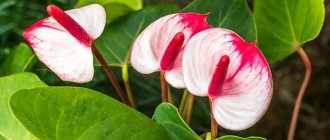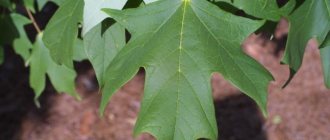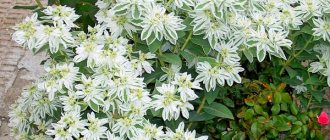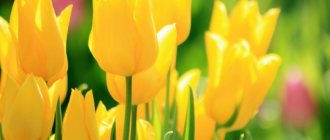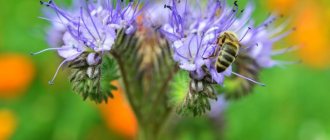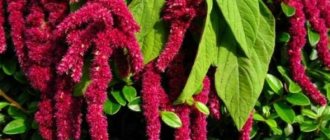The herbaceous perennial plant Euphorbia usually has a bare stem, and the root is characterized by a branched structure. The leaves are arranged in whorls, and the inflorescences look like umbrellas. A special feature of the plant is the fruit, which splits into several nuts.
In many types of milkweed, especially those growing in open ground, almost every part is rich in milky juice.
Species diversity
Euphorbia is a medicinal plant. It contains useful substances that can be used in the treatment of many ailments. But this is also a poisonous plant, so it is not recommended to leave it in the house within reach of children.
Among the most popular species are varieties that are planted in the garden during landscaping. But there are also varieties adapted to indoor conditions:
- Cereus-shaped - a small prickly bush with bright coral-colored flowers;
- Resinous - grown in the garden or on terraces, reaches 1 m in height and is covered with small yellow flowers;
- Tirukalli is a species rich in milky juice, and therefore very poisonous, grows quickly and has an elegant crown;
- Triangular - reaches 3 m in height, distinguished by purple-pink leaves;
- White-leafed - resembles a palm tree, the trunk thickens towards the top, which is decorated with oval-shaped leaves with white veins;
- Globular - a small plant, not exceeding 10 cm, with cylindrical shoots without thorns;
- Poinsettia is a deciduous shrub with contrasting foliage.
The richness and visual appeal of various varieties is presented in the photo of milkweed.
general information
Garden spurge most often refers to Euphorbia multiflora. This is a spherical shrub with a diameter of 50 cm to 1.5 m, depending on the variety. Among them there are annual and perennial varieties.
Milkweed has interesting leaf colors. They can be not only green, but also bluish or gray. Greenish-yellow flowers, at first glance, blend into the background, but become brighter as they bloom. Moreover, there are a lot of them, because every young shoot ends in an inflorescence.
Euphorbia leaves can be elongated, curled, oval, wavy - whatever. Basically, in size they reach a maximum of 8 cm. Leafy flowering shoots look like small individual bouquets.
Photo: greenmebrasil.com
Reproduction methods
The plant propagates by cuttings and seeds. The easiest way is cuttings. They are cut in the last weeks of spring. To do this, you need to pick up a 7-centimeter branch. You need to take it under the leaf node. After you have cut the branch, you need to carefully remove the lower leaves.
The cutting is placed in water to release the juice. Then you need to wipe the twig and treat all cut areas with charcoal. The cuttings are dried for 2-4 days, after which they are planted in sand. The substrate must be constantly moistened and kept in a shaded place.
The collected seeds must be dried by spreading them on paper or a piece of fabric. They should not be stored longer than 1 year.
It is recommended to germinate seeds in a sand and peat substrate. You can prepare it yourself or purchase an already processed mixture in the store. Sow the seeds in separate pots.
Such separation is required to prevent the spread of possible infection. When growing garden species, seeds should be sown in late autumn or early spring.
Preparation and storage
To properly collect flowers, you need to make sure that the plant being harvested is milkweed. After all, if you collect the wrong herb, it will not have the desired effect, and otherwise poisoning or other negative consequences may occur.
When harvesting the herb, spurge should not be allowed to include other medicinal plants. It is better to collect in areas where large quantities grow.
Folk recipes use the root, stems and juice. All these parts should be prepared separately. The juice is obtained from the fresh plant. Then it is evaporated in a water bath and placed in glass containers. Store blanks only in a cool place.
Euphorbia roots are harvested in early spring. This is done before the first leaves appear. You can also harvest them in late autumn, when the plant begins to wither. The dug up roots are cleaned of dirt, washed, treated with boiling water and dried at a temperature of 40 degrees.
The stems and grass of milkweed are collected before it blooms. After harvesting, the juice is squeezed out and the plant is laid out to dry.
Euphorbia flowers are harvested on rare occasions and then placed in places where the sun's rays do not reach. The finished raw materials are placed in glass jars for storage.
The dried plant can be stored for no more than 1 year. After this period, its medicinal properties are lost.
Features of temperature conditions
In summer, the recommended temperature is 22-25 degrees, and in winter it is enough to maintain 14-16 degrees above zero. It would be optimal to provide sunlight during the summer and winter periods. But the plant needs to adapt to direct rays gradually. By placing it on the south or southeast side, you need to protect the plant from burns.
If there is not enough natural light in winter, artificial lighting will be provided. For large bushes, placement on the floor is suitable, providing the required amount of ultraviolet radiation.
Remember that Cereus spurge will thrive in direct sunlight, but white-veined spurge is more prone to shaded areas.
Caring for milkweed at home
Due to significant differences in the appearance of various milkweeds, there are no uniform rules for growing these plants. Most often, euphorbia succulents are chosen to decorate apartments, so the features of caring for such species will be described below.
Lighting
The optimal daylight hours for milkweed is approximately 10 hours. However, many such plants are not afraid of direct sunlight. They can be kept on windows facing south, southeast or southwest. But on the foliage of some types of milkweed, the bright sun can leave burns. In this case, diffused light should be provided for the bushes. To ensure uniform development of the green part, it is recommended to periodically turn the pot. In the summer, milkweeds can be transferred to the garden, choosing a place for them that is sheltered from strong winds.
If plants lack light, they will grow much more slowly, and sometimes may completely wither. In dark rooms, phytolamps can be used to compensate for the lack of natural light.
Temperature
In summer, you can grow milkweed at temperatures of about 20-25 degrees. These plants are considered quite resistant to heat. Beautifully flowering species require a period of rest in winter - during this time they try to keep them cool. To form buds, such plants require a temperature of about 14 degrees. The lower threshold is considered to be 10 degrees.
Euphorbias tolerate temperature changes quite well, but react extremely negatively to drafts. The room where there are pots with such flowers should be ventilated more carefully.
Watering
The abundance of watering can be judged by the appearance of the milkweed. The more its bush resembles representatives of cacti, the less water it will require. However, any plant should not be over-watered frequently. It is worth watering the spurge abundantly only when the soil ball has dried out by about a quarter. Stagnation of moisture and acidification of the soil harm plantings, especially species with fleshy stems.
Some euphorbias are considered more moisture-loving. These species include Mil's milkweed, which sheds its leaves when drought occurs. The soil should not be allowed to dry out completely when growing other types of flowers.
If milkweed rests in a cool place in winter, the amount of watering must be reduced. Otherwise, there is a risk of developing root rot of the plant.
Humidity level
Milkweed does not require high levels of humidity. Such plants do well in normal apartment conditions. They tolerate dry air better than humidified air, so even dusting leaves can be done with a dry brush or napkin.
The soil
Suitable soil for planting milkweed should conduct air well and have sufficient looseness. The soil reaction should be neutral. You can use ready-made substrates for succulents or cacti, or prepare the soil yourself. Its composition includes sheet soil, turf, peat, coarse sand and brick fragments, taken in equal proportions. A drainage layer must be laid at the bottom. You can use expanded clay for it.
A fairly wide and not very deep pot is suitable as a container for milkweed. When transplanting older and larger specimens that can overturn the container, you should use heavier pots or place weighting stones on their bottom.
Feeding
Milkweed does not require nutritious soil, so the plant does not need frequent feeding. No more than 2 times a month it can be fed with the composition for cacti or succulents in a standard dosage. During the dormant period, fertilizers are not applied.
Transfer
Euphorbia is transplanted into a new container only if necessary: when the roots of the plant no longer fit in the old pot. Usually the pot is updated every few years. The new container should exceed the old one by about a couple of centimeters.
Trimming
White-leafed and ribbed milkweeds, as well as cactus-like succulents, do not need to be pruned. Only branching varieties usually need pinching, including Mil's milkweed. This procedure promotes the development of a more luxuriant crown and prevents the bush from growing excessively in height. Dry stems must also be removed. Pruning is carried out after the bush has flowered or approximately in the middle of the summer season.
Irrigation system
The spring-summer period is a time of moderate soil moisture. When deciding to water, you need to evaluate the soil. If it has already dried out, but is not completely dry, then adding water will be appropriate. In winter, the decrease in temperature is compensated by a decrease in the frequency and volume of watering.
The soil should dry out between moistenings. Overmoistening is more detrimental to the plant compared to dryness. It is recommended to use soft water at room temperature.
White-veined spurge or poinsettia requires frequent watering, unlike leafless varieties. Spraying milkweed is done largely as a hygienic procedure.
Biological description
What does a spurge flower (Euphorbia) look like: the culture belongs to annual or perennial herbaceous shrubs and is a representative of the Euphorbia family. The succulent has succulent foliage and shoots that have the ability to accumulate moisture. If platinum leaves are accidentally damaged, a milky sap is released from the wounds, protecting the plant from attack by parasitic insects.
Blooming spurge
Juice includes:
- amino acids;
- sterol;
- rubber;
- essential oil;
- resin;
- sugar.
Important! If the juice gets on the skin, inflammation may occur as a consequence of a superficial burn. When caring for garden crops, you must use thick gloves.
Perennial euphorbia develops as a tree or shrub and looks like a cactus. The succulent prefers tropical or subtropical climates. The leaf blades of the plant come in different shapes:
- toothed;
- oval;
- narrow;
- whole-edged;
- ovoid.
Euphorbia white-veined
In the milkweed cactus, the leaves are arranged oppositely; the inflorescence contains one pistillate flower and stamens of the male subspecies. The buds are divided into groups using bracted foliage, colored in a variety of shades. The crop blooms in June – July.
Important! Some subspecies of yellow euphorbia bloom buds only with the arrival of autumn coolness.
Feeding procedure
Euphorbia needs to be fed regularly as the plant grows. This is done every 2 weeks, adding special compounds for cacti and succulents. For flowering varieties, fertilizers for similar plants are more suitable, but the concentration should be reduced by 2 times compared to the dosage indicated in the instructions.
Milkweed species that are spherical in shape or have thick stems should not be fertilized with nitrogen-containing compounds. Excess of this component will lead to cracking of the skin. Fertilizers for orchids will be useful.
Appearance
It is quite difficult to answer the question of what milkweed looks like. And all because there are 2000 species. So, one type of milkweed may look like a cactus, another looks like a miniature palm tree, and a third looks like a bush or ordinary grass. There are only a few characteristics that unite all this diversity into one family.
- Stem. Very “fleshy”, like all succulents (plants that store water in the stem). Structure, length, color depend on the species. They often have clearly defined edges and scars from fallen leaves.
- The structure of the inflorescence. Each new flower seems to grow from the old one. The flower has no petals and consists of one twisted pistillate floret. Around are the remains of degenerate flowers - stamens, bracts. Blooms for a long time.
- Fetus. Ripens at the end of flowering. It looks like a triangular box with three seeds.
- Leaves. Usually dense, elongated, with reddish veins (but this is not a necessary condition).
- The presence of white milk when a leaf or stem is fractured. This is the only thing that is necessarily present in any type of milkweed!
Replanting and pruning
For young plants, regular replanting is required at intervals of 1-2 years, and for older plants - after 2-3 years. Euphorbia is planted in pots, the bottom of which is filled with drainage.
The soil mixture is prepared using garden and leaf (or peat) soil, sand and brick chips (or vermiculite) in equal parts. You can add a small amount of birch charcoal. It is useful to add rotted manure to the soil.
Euphorbia brilliant or variety Mil requires regular pruning to give the shape of a bush. It is important to remove dried shoots in a timely manner, and leave strong and healthy ones to form flowers for a future period.
How does it reproduce?
To reproduce, the wild plant uses side shoots and seeds, which it has in large quantities. This is the reason why it takes so long to get rid of the weed.
The main methods of propagating milkweed:
- using seeds;
- dividing the bush;
- leaf or stem cuttings.
If you do not completely remove the plant from the soil, new shoots will form on the remaining root system over time. The weed will begin to grow even more intensely until it turns into a bush.
Disease and pest control
If, when replanting a plant, you find root worms, then the bugs should be washed with water heated to 45 degrees. And then for 30 days the soil is watered with aktara weekly.
To combat aphids, tinctures of onion, garlic, and mustard are suitable. The spider mite will go away after treating the plant with soap solutions, alcohol, and insecticidal preparations.
If a white coating appears on the leaves, wash the plant with a soap solution mixed with machine oil. But before that, you need to remove the mealybug bugs. Tobacco and garlic tinctures and calendula infusions are useful for the fight.
However, along with the effects of pests, more natural problems are also possible:
- Leaf loss is often associated with lack of sunlight. Therefore, the flower needs to be moved to a brighter place.
- The wilting of milkweed is caused both by the action of pests and by a banal draft.
- Drying and yellowing of leaves is caused by pests and lack of moisture.
The benefits and harms of the flower
The plant has diaphoretic, anti-inflammatory, analgesic, and diuretic properties. Euphorbia is taken externally and orally. Modern supporters of alternative medicine, aware of the benefits of the culture, use infusions based on it for cystitis, various lesions of the dermis, as well as diseases of the stomach and upper respiratory tract.
Many people are interested in why indoor spurge is dangerous. The leaves and stems of the plant contain a high concentration of a substance that causes poisoning in animals and people. The poisonous juice of the plant provokes a severe allergic reaction on the skin. Symptoms appear within an hour. First, a burning sensation is felt at the site of impact, and then numbness spreads throughout all limbs.
Important! The presence of a toxic substance requires careful attention to therapy. You should not self-medicate without first consulting a doctor or experienced herbalist. In addition, it is necessary to be able to properly prepare drugs, observing all safety precautions.
If a dangerous substance enters the body, it can cause problems with the digestive system. If the juice gets into the mucous membranes of the eyes, vision can be seriously damaged. There are no known deaths due to milkweed poisoning, but it is best to call an ambulance as medical attention will be needed. To prevent this from happening, pruning is done with gloves. It is not recommended to grow milkweed if there is a possibility that pets or children will get to it.
Medicinal properties of milkweed
Tinctures and decoctions of milkweed are useful in the fight against skin diseases, stomach and liver ailments. Alcohol tinctures are used as an effective homeopathic remedy. The plant's antitumor properties are also known. Milkweed honey, rich in iodine, is useful for gastritis, ulcers, varicose veins, cardiovascular diseases, and nervous system disorders.
But such medications must be used with caution. You should not make treatment decisions on your own. Consumption by children and women during pregnancy and lactation is strictly prohibited.
Euphorbia is not only an ornamental garden and indoor plant. This is a fairly effective remedy that is useful in the fight against numerous diseases.
Why indoor spurge is dangerous
Euphorbia juice can be harmful if it comes into contact with the skin and mucous membranes of humans, especially children. Upon contact with the skin, it can cause inflammation and even severe burns.
Getting the juice into the eyes is dangerous and can lead to loss of vision. And if it gets into the mouth, symptoms of poisoning may appear: swelling of the tongue, nausea, vomiting, dizziness, convulsions, fainting, fever, breathing problems. An allergic reaction is possible. If the above symptoms occur, you should immediately consult a doctor.
Photo of milkweed
Useful qualities
What are the medicinal properties of the herb spurge? Preparations based on the plant are actively used to heal wounds on the skin. They are used in the form of baths or tinctures to treat fungus and gout. Euphorbia juice works well on warts that are lubricated with it. A more common method is treatment using a decoction of the plant.
In folk medicine, euphorbia was used as a remedy with laxative, anthelmintic and diuretic properties. Currently, the range of its use has increased significantly.
Euphorbia slows down the growth of tumors, cleanses the blood and prevents the growth of metastases. The lactones contained in the herb have antitumor properties. Due to its healing qualities, euphorbia is used to treat various tumors. It is often used for sarcoma. The plant is effective during the period of restorative chemotherapy.
Euphorbia can be used internally to combat worms. A decoction of the plant is effective for anthrax, rabies and paralysis.
Women can use it to treat mastopathy, uterine fibroids and infertility.
Euphorbia is often used to treat anemia. It is used for serious development of tuberculosis, as well as for complex therapy of bronchitis, bronchial asthma and pneumonia.
Having bactericidal properties, spurge can relieve inflammation due to cystitis. For diarrhea, the decoction relieves symptoms due to the presence of tannins in the plant.
The root of the herb is used to treat headaches and treat problems of the male genital area. Euphorbia root extract is considered a powerful emetic. Therefore, it can be used for bites of rabid animals and acute intestinal diseases.
Currently, the properties of milkweed are also used in official medicine. Its infusions in low concentrations are used in the treatment of kidney diseases, hemorrhoids, eczema and skin fungus. The herb relieves inflammation and reduces pain.
People who are overweight can take a decoction of milkweed. The plant helps to increase the protective functions of the body. It is best used in the autumn-winter period to prevent colds.
Due to the poison contained in the plant, caution should be exercised when used externally.
How to get rid of milkweed
The real reality is that milkweed can be found both in the wild and in vegetable gardens anywhere in the world. It's all about his vitality and ability to adapt. He is not afraid of either heat or frost. That is why the plant is called the scourge of agriculture.
In recent decades, the thickets of this weed have increased also because the area of agricultural crops has decreased: most fields have turned into virgin soil: they are not plowed or cultivated.
Euphorbia is a nasty weed that is very difficult to get rid of. And it absolutely must be destroyed. Having settled on a summer resident’s plot or a farmer’s field, the plant begins to settle in the territory, taking over it like a real aggressor.
The active growth of the garden weed, the photo of which is below, begins earlier than other plants. His growth bud is rapidly developing. When a gardener digs up the beds and applies fertilizers, he feeds not only cultivated plants, but also weeds, including milkweed.
No matter what agricultural practices you use, you will not be able to remove the weed if the seeds are still in the ground.
Comment! The seed material of the milkweed weed, as well as the roots, can “freeze” in the ground for several years if there are no conditions for their germination.
Folk recipes from milkweed
The medicinal properties of milkweed have found their application in the treatment of the following diseases:
- Tincture for the treatment of fungus, eczema and lichen. 1 teaspoon of herb is poured into 500 ml of boiling water. Let it sit for half an hour and strain. The product should be used as baths. To treat lichen, use the juice of a fresh plant, which is applied to the sore spot. Leave for 20 minutes and rinse thoroughly with water.
- Gastrointestinal diseases. 5 grams of root are poured into 1/2 liter of water. Boil the liquid for 10 minutes. Take the product 3 times a day, a tablespoon a quarter of an hour before meals.
- Getting rid of freckles or age spots. Apply the juice of the plant to your face and wash it thoroughly after 10-15 minutes.
- Treatment of calluses. This recipe has been known since ancient times. Apply the grass juice to the calluses and put on socks. The procedure is carried out at night, for 6-7 days. In the morning, wash off the juice and apply pumice.
- Depilation. To facilitate the process, add a teaspoon of plant juice to 100 grams of boiled water. Wipe the area where depilation is planned. The procedure will go faster, and the hairs will grow slower.
By using the herb euphorbia in the treatment of diseases, you can quickly reduce their symptoms.

